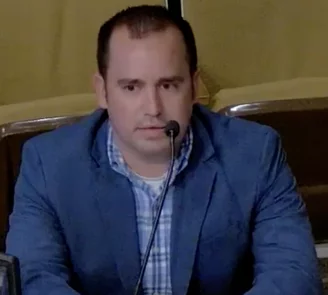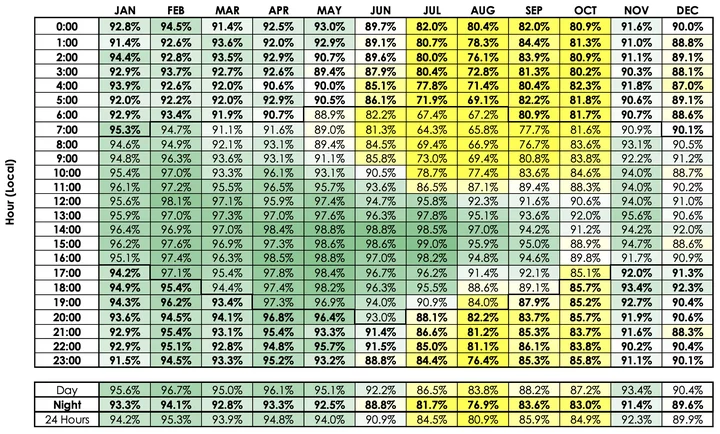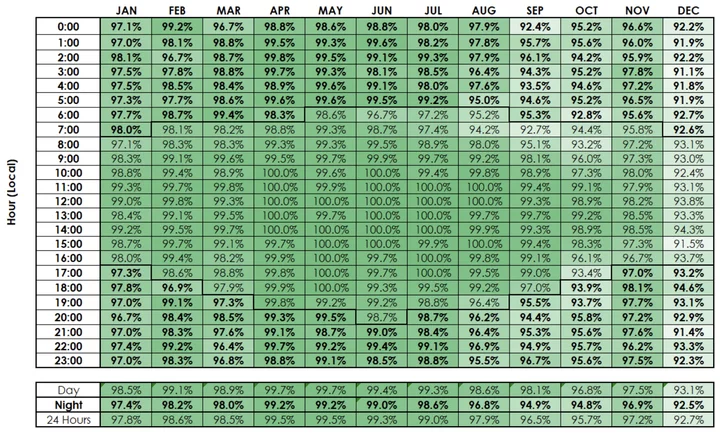Screenshot of Tuesday’s Humboldt County Board of Supervisors meeting.
###
There are several big improvements slated for the California Redwood Coast-Humboldt County Airport. In just a few days, the county is going to shut down ACV for two weeks to accommodate much-needed improvements to the airport’s main runway, which was last rehabilitated nearly 30 years ago. Along with that, aviation staff are looking at some big-picture improvements to curtail flight delays.
During today’s regular meeting, the Humboldt County Board of Supervisors took its first look at the preliminary findings of a study looking at the feasibility of implementing an enhanced Instrument Landing System that would significantly reduce aircraft diversions, delays and cancellations at the airport.
Cody Roggatz, Humboldt County’s Director of Aviation, acknowledged the airport’s history of delayed departures and cancellations but maintained that it is “on par with the national average.”
“We often hear from the public about people not flying from ACV because the fog cancels all of the flights or delays all of the flights. That isn’t the case,” Roggatz said. “We are actually right on par with the national average for cancellation rates and delays, but we understand that the fog can be a challenge at times. We’ve started exploring what we can do to improve our performance and be better with the on-time and cancellation rates, be better than that national average, and that led us, of course, to the Instrument Landing System.”
The Humboldt County Airport’s existing Instrument Landing System uses a Category I approach, meaning it can only accommodate incoming aircraft when the visibility is more than half a mile or when the cloud ceiling is 200 feet above the runway. A Category II system, on the other hand, can accommodate a minimum visibility of 1,200 feet (just under a quarter-mile) and a 100-foot cloud ceiling.
Paul Hannah, Chief Flight Operations Engineer for Lean Technology Corporation, one of the entities the county hired to perform the feasibility study, said visibility is generally at its worst between July and December, causing more delayed departures and cancellations at the airport. He gestured to the graph below, which depicts the average weather conditions at the airport for every hour of each month.
Category I approach: Cloud ceiling/visibility create prolonged periods between July and December where on-time operations are difficult to achieve. | Screenshot
“These percentages break down to the way that airlines, in particular, think about the airport and how they make their scheduling decisions on when they want to come into the airport,” Hannah said. “Here we are in August, and this morning the visibility was less than a half mile. If there was an airline that wanted to come into the airport in the morning [and] they look at the current situation, they know that there’s basically a 60 percent chance. To put that in perspective, for a hub airport like San Francisco, that number would be 99 [percent].”
A Category II approach Instrument Landing System would bring ACV up to par with most other airports, he said, bringing the likelihood of landing on a foggy August morning up to 90 percent.
The Category II approach would “significantly” improve the airport’s ability to retain on-time arrivals year round. | Screenshot
Once the feasibility study is complete, staff will have a better idea of the improvements needed to implement a Category II approach system, Hannah said.
“There are some interesting challenges [that are] very unique to the airport that we’ll be discussing how we can overcome, especially in the absence of an air traffic control tower,” he said. “One of the outcomes of this feasibility study may be that the airport achieves an air traffic control tower at some point in the future.”
First District Supervisor Rex Bohn asked who would foot the bill for the improvements and whether the county could receive funding from the Federal Aviation Administration (FAA).
“That’s going to be our goal,” Roggatz said. “There are multiple components that make [the Category 1] system up on our airfield and it’s all owned by the FAA. Ultimately, we would try to keep it that way. … It’ll be a little bit more elaborate when we start the in-depth conversations with the FAA, but our plan is to start the conversation by laying those two datasets side by side and essentially [asking], ‘Tell us why we can’t do this.’ It shows and highlights … how important this [upgrade] really is to our community.”
Bohn asked if staff had any idea how much the entire improvement project would cost. Hannah said the project would “definitely be in the multiple millions of dollars,” reiterating that the goal is to have the FAA “provide as much funding as possible.” Additional enhancements, including the construction of an air traffic control tower, would cost even more.
Bohn asked if it was true that the majority of flight delays to the Bay Area are caused by SFO rather than ACV. Roggatz confirmed, adding that SFO has capacity constraints that “often impact smaller markets like us.”
“As we brought on Los Angeles and Denver … with their direct flights, our on-time performance and our cancellation rates have improved because not everything is going to and from SFO,” Roggatz continued. “The majority of the struggles that we’ve had have been related to SFO. We’re trying to take that next step as we explore this option to make sure that it’s always an SFO issue and never an ACV issue.”
Before closing out the discussion, Roggatz reiterated that there will be no commercial air service at ACV between Aug. 14 and Aug. 25 to accommodate a big repaving project on the airport’s main runway. You can read more about the Runway and Electrical Rehabilitation Project here.
The board unanimously agreed to file the report but did not take any further action on the item.
SB 252: Fossil Fuels Divestment
The board also narrowly approved a letter of support of a Senate bill that would prohibit the boards of the California Public Employee Retirement System (CalPERS) and the California State Teachers’ Retirement System (CalSTRS) from making new investments – or renewing existing investments – in fossil fuel companies and would require that the two boards liquidate all such investments by July 1, 2031, according to the text of SB 252.
The letter, initiated by Third District Supervisor Mike Wilson and Fifth District Supervisor and Board Chair Steve Madrone, offers its “wholehearted” support of the bill, noting that the requirement “is one part of the state’s broader efforts to decarbonize the California economy and to transition to clean, pollution-free energy resources.”
“There [are] a lot of retirement funds across the United States – both public and private – that are moving in this direction,” Wilson said. “Divestiture from these types of things is common but also something that deserves discussion.”
Speaking during the public comment portion of the discussion, retired public school teacher Debroah Dukes lamented the fact that she has to spend her retirement fighting against the fossil fuel industry rather than “having fun and doing useless things.”
“I spent my career devoted to the next generation and, by extension, the generations after that,” she said. “I divested from fossil fuels against the advice of my financial advisor … and it bothers me tremendously that my pension … is benefiting from fossil fuel money. … I would urge you to write this letter of support.”
Second District Supervisor Michelle Bushnell, who pulled the item from the consent calendar for further discussion, said she wanted more time to investigate the item before signing a letter of support.
“My community is a very rural area that is very dependent on different sources,” she said. “While I support the … values [of this bill], I am not supportive of not investigating a little farther and deeper before I put my name to something.”
Bohn agreed and said he’d like some more information as well. “There’s just too shallow of a pool of information here for me,” he said. “There’s too many questions without answers.”
Fourth District Supervisor Natalie Arroyo said she understood the importance “of wanting to ensure that our retired employees have good returns on their investments” but emphasized the importance of pushing the state toward its climate goals.
“I think every element in every way of approaching this helps and gets us closer to our goals,” she said. “It’s one thing to say individuals should be responsible for their own actions with a wide variety of financial capacities and abilities to make those types of changes in their lives. It’s quite another to say that, you know, the state should look at higher-level policies around investments. I support this fully and I appreciate the urging to do all we can around this.”
Arroyo made a motion to approve the letter of support, which was seconded by Wilson. The motion passed in a 3-2 vote, with Bohn and Bushnell dissenting.
###
Other odds and ends from the meeting:
- The board also received an update on the county’s pilot program with Hambro Recycling and CalRecycle to accommodate California Refund Value (CRV) services in the county. The board reviewed existing Recycling Convenience Zones throughout the county and whether or not the zones should be expanded. In a somewhat complex motion, the board voted to continue the pilot program, to extend the Recycling Convenience Zones “as broad as possible,” and to connect with other rural counties through the California State Association of Counties (CSAC) and the Rural County Representatives of California (RCRC) to “get a team together” and initiate legislation to ensure “that these remote areas can be serviced.”
- Several members of SEIU Local 2015 spoke during the public comment portion of the meeting to urge the board to support in-home supportive care workers and ensure seniors and people with disabilities can access the life-saving care they need. The group began chanting in board chambers. Madrone asked the group to stop chanting but said, “Thank you. We hear you.”
- At the end of the meeting, Bohn noted that improvements to the Ferndale Fairgrounds will wrap up at the end of this week, about a week ahead of opening day at the Humboldt County Fair.




CLICK TO MANAGE